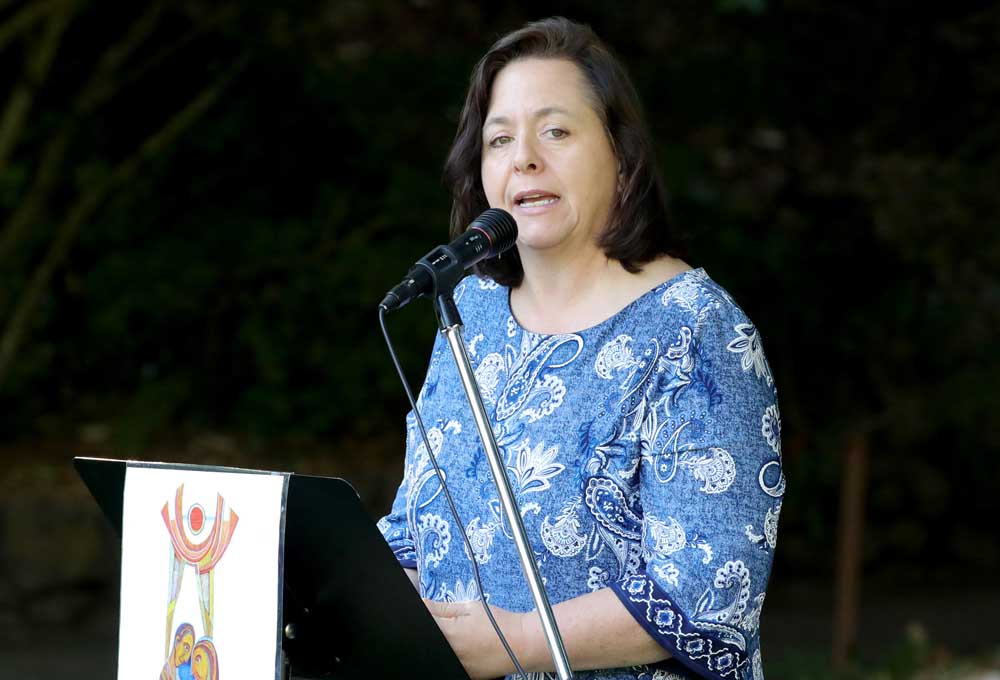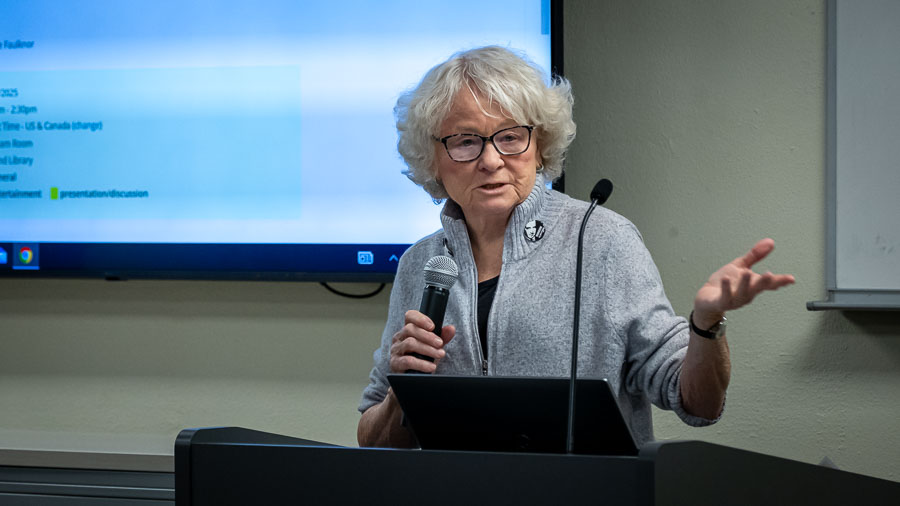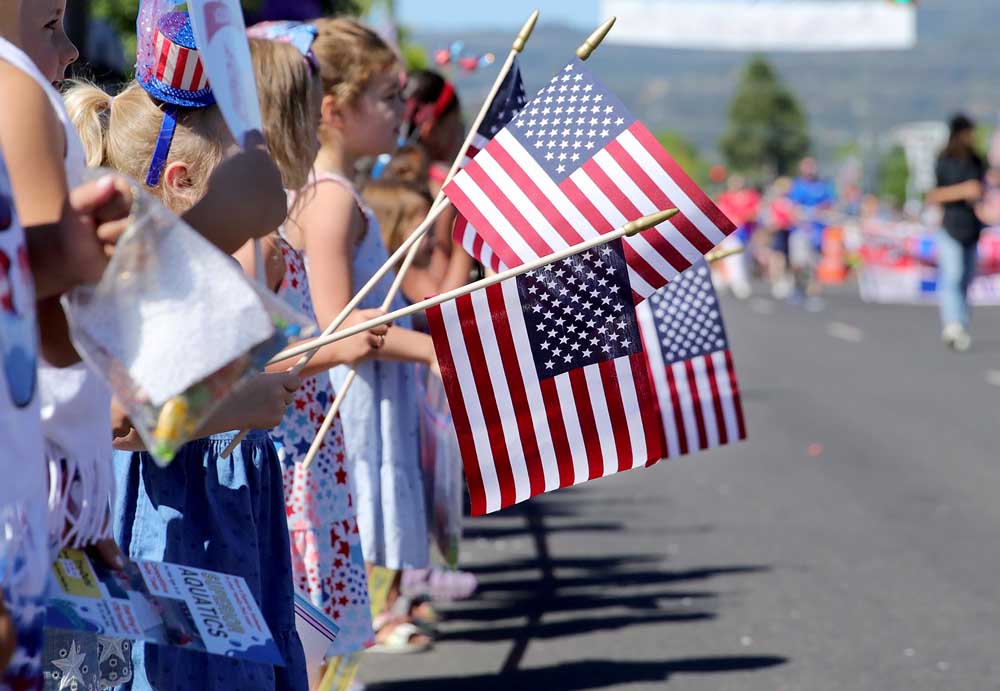‘This can never happen again’: Hiroshima survivor speaks at vigil in Ashland
Published 4:00 pm Tuesday, August 6, 2024

- Ashland Mayor Tonya Graham reads a proclamation during the Rogue Valley Hiroshima-Nagasaki Vigil at Lithia Park in Ashland on Tuesday.
Sunlight filtered through the trees over the entrance of Lithia Park on Tuesday morning as dozens of community members arrived for the annual Rogue Valley Hiroshima-Nagasaki Vigil.
Tidy rows of white chairs on the green lawn slowly filled as music played before the event.
Hosted by Ashland’s Peace House with a list of community members each standing to speak, the 79th anniversary of the bombing of the city of Hiroshima in Japan included time for attendees to reflect on the days that followed the historic event and on world events now in the news.
The Rev. Dr. Fred Grewe, of the Ashland Congregational United Church of Christ, offered an invocation, reminding attendees that the bombing was a painful reminder of “what we are capable of as a species when we surrender to the voices of fear,” and of what human beings can do “at our worst.” “We must love one another … or die,” Grewe said.
Cynthia Taylor, a Peace House board member, lit a memorial flame prior to several long moments of silence. The ringing of a gong took place at exactly 8:15 a.m., the minute the 9,000-pound atomic bomb was dropped Aug. 6, 1945, immediately killing 80,000 people, with tens of thousands dying from radiation fallout in the aftermath.
For the event’s guest of honor, Hiroshima survivor Hideko Tamura Snider, the vigil brought contrasts and similarities to the fateful day as a happy 10-year-old girl when her home was destroyed, her mother and best friend killed, and her life forever changed.
Snider remarked that heat and lingering wildfire smoke in recent weeks often reminds her of those days that followed the bombing, while the blue skies reminded her of the hope she would eventually find.
Snider, who came to America and worked for more than four decades as a psychiatric social worker, has devoted her life to sharing a message of healing and peace. In addition to participating each year in the anniversary of the worst day of her life, she’s visited the Enola Gay, the plane from which the bomb was dropped, authored a book on her experience, “A Sunny Day,’ and a children’s book, “When a Peace Tree Blooms.”
She founded a nonprofit, One Sunny Day Initiatives, in 2007, and organized local efforts to germinate and grow the seeds of “peace trees,” using seeds from seven trees that recovered from the blast.
After the sounding of the gong on Tuesday, Snider, who turned 90 in January, bowed her head and closed her eyes for several long moments before rising to speak.
Before a silent crowd, she recalled searching the ashes for lost loved ones, of being “inside the mushroom cloud” and eventually crawling toward a faint ray of sunlight that forced its way through burning smoke.
“After 15 minutes of pitch dark, I said to myself, ‘This is how we die. My body is going to break up at any moment,‘” Snider told the crowd.
“There was a faint light coming through … I managed to somehow crawl towards that faint light.”
The faint light, Snider noted, was “symbolic of life itself.”
“Everyone here, you represent the faint light. And that faint light saved me because I somehow crawled out. … And when the mushroom cloud cleared out, there was a blue sky just like we have here right now.”
Snider noted that post-Hiroshima “wasn’t simple.” Like life, she noted, it was “complicated and scary.”
“Life isn’t too simple … but it is what we make of it,” she said.
Following Snider’s remarks, Japan resident Masako Cross performed a song called {%%note} {/%%note}”Souls.” Mayor Tonya Graham and local peace activist Herb Rothschild addressed the crowd. Graham said the vigil, held in Ashland since 1982, was a time to “recommit ourselves and make sure that we are doing everything we can so that this never happens again.”
The vigil concluded with a traditional water ceremony, where guests ladled cold water onto a smooth rock to honor the victims of the bombing and others who have suffered from nuclear production.
Afterward{%%note} {/%%note}, Snider said recognizing that vigils were being held all over the world at the same time felt like “a joining of hands all around the world … the same energy that has kept 79 years of safety without the further use of nuclear weapons.”
With the ongoing war between Russia and Ukraine, Snider, wearing a “Peace for Ukraine” pin on her shirt, said it was heartbreaking to see current events mirror those from her own past.
“Japan knows very well how Russia behaves. Since they went into Ukraine, we are all seeing how it can happen,” Snider said.
“I am behind Ukraine. Peace is more important than ever.”
Snider said warm temperatures brought distant memories closer to home. Summer heat each year, she noted, serves as a reminder of her past.
“I was an only child when the bomb was dropped. My mother didn’t come home. As far as I was concerned, the sun and the earth melted together that day,” Snider said.
Watching people take part in the water ceremony, Snider said commitment to a peaceful world “is the only way.”
“It is within the human nature to have the wars … It’s in all of us, from the DNA of the Big Bang,” Snider said.
“We all have to continue to work for peace … because this can never happen again.”
‘Seeds of Peace’ A documentary planned for release in 2025, “Seeds of Peace,” is a detailed account of the life and work of Hiroshima survivor Hideko Tamura Snider. Snider is the founder of One Sunny Day Initiatives and has helped to plant trees through the Oregon Peace Tree Project. The trees are planted from the seeds of trees that survived the atomic blast over Hiroshima. For more information on the documentary, visit outdoorhistoryconsulting.com/seedsofpeace
A documentary planned for release in 2025, “Seeds of Peace,” is a detailed account of the life and work of Hiroshima survivor Hideko Tamura Snider.
Snider is the founder of One Sunny Day Initiatives and has helped to plant trees through the Oregon Peace Tree Project. The trees are planted from the seeds of trees that survived the atomic blast over Hiroshima.
For more information on the documentary, visit online.










